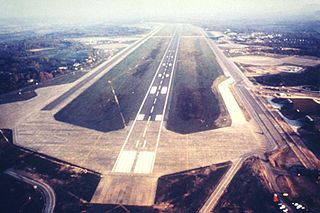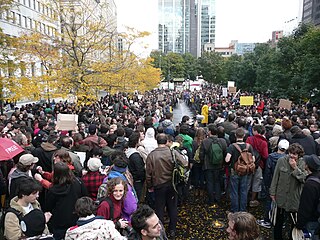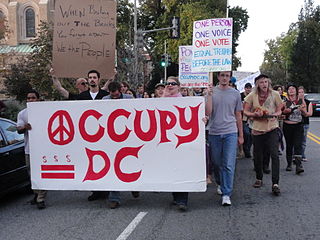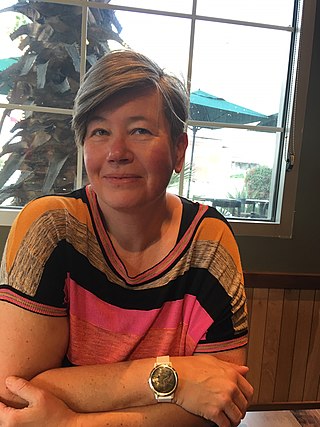
Royal Air Force Greenham Common or more simply RAF Greenham Common is a former Royal Air Force station in the civil parishes of Greenham and Thatcham in the English county of Berkshire. The airfield was southeast of Newbury, about 55 miles (89 km) west of London.

Peace camps are a form of physical protest camp that is focused on anti-war and anti-nuclear activity. They are set up outside military bases by members of the peace movement who oppose either the existence of the military bases themselves, the armaments held there, or the politics of those who control the bases. They began in the 1920s and became prominent in 1982 due to the worldwide publicity generated by the Greenham Common Women's Peace Camp. They were particularly a phenomenon of the United Kingdom in the 1980s where they were associated with sentiment against American imperialism but Peace Camps have existed at other times and places since the 1920s.
A bolt cutter, sometimes called bolt cropper, is a tool used for cutting bolts, chains, padlocks, rebar and wire mesh. It typically has long handles and short blades, with compound hinges to maximize leverage and cutting force. A typical bolt cutter yields 20 kilonewtons (4,500 lbf) of cutting force for a 250 newtons (56 lbf) force on the handles.
Stop the City demonstrations of 1983 and 1984 were described as a 'Carnival Against War, Oppression and Destruction', in other words protests against the military-financial complex. These demonstrations can be seen as the forerunner of the anti-globalisation protests of the 1990s, especially those in London, England, on May Day and the Carnival against Capitalism on 18 June 1999. They were partially inspired by the actions of the Greenham Common Women's Peace Camp.
Faslane Peace Camp is a permanent peace camp sited alongside Faslane Naval base in Argyll and Bute, Scotland. It has been occupied continuously, in a few different locations, since 12 June 1982. In 1984, the book Faslane:Diary of a Peace Camp was published, co-written by the members of the peacecamp at the time. There is also a secondary site on Raeberry Street in North Glasgow.

Greenham Common Women's Peace Camp was a series of protest camps established to protest against nuclear weapons being placed at RAF Greenham Common in Berkshire, England. The camp began on 5 September 1981 after a Welsh group, Women for Life on Earth, arrived at Greenham to protest against the decision of the British government to allow cruise missiles to be stored there. After realising that the march alone was not going to get them the attention that they needed to have the missiles removed, women began to stay at Greenham to continue their protest. The first blockade of the base occurred in March 1982 with 250 women protesting, during which 34 arrests occurred.

As an act of protest, occupation is a strategy often used by social movements and other forms of collective social action in order to squat and hold public and symbolic spaces, buildings, critical infrastructure such as entrances to train stations, shopping centers, university buildings, squares, and parks. Opposed to a military occupation which attempts to subdue a conquered country, a protest occupation is a means to resist the status quo and advocate a change in public policy. Occupation attempts to use space as an instrument in order to achieve political and economic change, and to construct counter-spaces in which protesters express their desire to participate in the production and re-imagination of urban space. Often, this is connected to the right to the city, which is the right to inhabit and be in the city as well as to redefine the city in ways that challenge the demands of capitalist accumulation. That is to make public spaces more valuable to the citizens in contrast to favoring the interests of corporate and financial capital.
The Seneca Women's Encampment for a Future of Peace and Justice was a women-only peace camp formed to protest the scheduled deployment of Cruise and Pershing II missiles before their suspected shipment from the Seneca Army Depot to Europe in the fall of 1983.

The anti-nuclear movement in the United Kingdom consists of groups who oppose nuclear technologies such as nuclear power and nuclear weapons. Many different groups and individuals have been involved in anti-nuclear demonstrations and protests over the years.

Anti-nuclear protests began on a small scale in the U.S. as early as 1946 in response to Operation Crossroads. Large scale anti-nuclear protests first emerged in the mid-1950s in Japan in the wake of the March 1954 Lucky Dragon Incident. August 1955 saw the first meeting of the World Conference against Atomic and Hydrogen Bombs, which had around 3,000 participants from Japan and other nations. Protests began in Britain in the late 1950s and early 1960s. In the United Kingdom, the first Aldermaston March, organised by the Campaign for Nuclear Disarmament, took place in 1958. In 1961, at the height of the Cold War, about 50,000 women brought together by Women Strike for Peace marched in 60 cities in the United States to demonstrate against nuclear weapons. In 1964, Peace Marches in several Australian capital cities featured "Ban the Bomb" placards.

Occupy Portland was a collaboration that began on October 6, 2011 in downtown Portland, Oregon as a protest and demonstration against economic inequality worldwide. The movement was inspired by the Occupy Wall Street movement that began in New York City on September 17, 2011.

The Occupy movement was an international populist socio-political movement that expressed opposition to social and economic inequality and to the perceived lack of real democracy around the world. It aimed primarily to advance social and economic justice and different forms of democracy. The movement has had many different scopes, since local groups often had different focuses, but its prime concerns included how large corporations control the world in a way that disproportionately benefits a minority, undermines democracy and causes instability.

Occupy Canada was a collective of peaceful protests and demonstrations that were part of the larger Occupy Together movement which first manifested in the financial district of New York City with Occupy Wall Street, and subsequently spread to over 900 cities around the world.

Occupy D.C. was an occupation of public space in Washington, D.C. based at McPherson Square and connected to the Occupy movements that sprung up across the United States in Fall 2011. The group had been demonstrating in McPherson Square since October 1, 2011, and in Freedom Plaza since October 6. Despite crackdowns on other Occupy projects across the country, federal authorities claimed on November 15 that they have no plans to clear McPherson Square Park. The National Park Service decided against eviction after meeting with activists and discussing health and safety conditions.

Occupy Melbourne was a social movement which took place from late 2011 to mid 2012 in Melbourne, Australia as part of the global Occupy movement Participants expressed grievances concerning economic inequality, social injustice, corruption in the financial sector, corporate greed and the influence of companies and lobbyists on government. Protests began on 15 October 2011 in City Square with a 6-day-long protest encampment, from which people were forcibly evicted by Victoria Police at the request of the City of Melbourne CEO on 21 October 2011. From 2 November 2011, Occupy set up camp in Treasury Gardens before being moved on from that location in December. A significantly diminished number of protesters set up camp at Father Bob's church at his invitation until his retirement in January 2012. Physical manifestations of the movement had largely dissipated by mid-2012 though it adopted a strategy of decentralisation and became influential in the creation of new community networks, affinity groups and collectives.
Helen John was one of the first full-time members of the Greenham Common peace camp in England, UK, and was an peace activist for over 30 years.

Helen Wyn Thomas was a Welsh peace activist from Newcastle Emlyn. Hers was the only death incurred in the course of the Greenham Common Women's Peace Camp campaign.

Sasha Roseneil is a group analyst and a psychoanalytic psychotherapist. Roseneil became the ninth vice chancellor of the University of Sussex in August 2022.
Sarah Hipperson was a midwife, magistrate and peace campaigner who spent 17 years living at the Greenham Common Women's Peace Camp on RAF Greenham Common protesting against the siting of American nuclear cruise missiles in the United Kingdom. In 1982, she founded Catholic Peace Action. Her nonviolent resistance resulted in over 20 imprisonments and several appearances in court. She lived to see the transformation of Greenham Common back into use by the public and was one of the last four women to leave the camp. She appeared as herself in the documentary Margaret Thatcher: The Woman Who Changed Britain.
Carry Greenham Home is a 1983 documentary about the Greenham Common Women's Peace Camp created by Amanda Richardson and Beeban Kidron. It bears the same name as the song by Peggy Seeger. It is considered "the first full-length documentary of a protest camp as a site of ongoing protest and daily living or re-creation."













